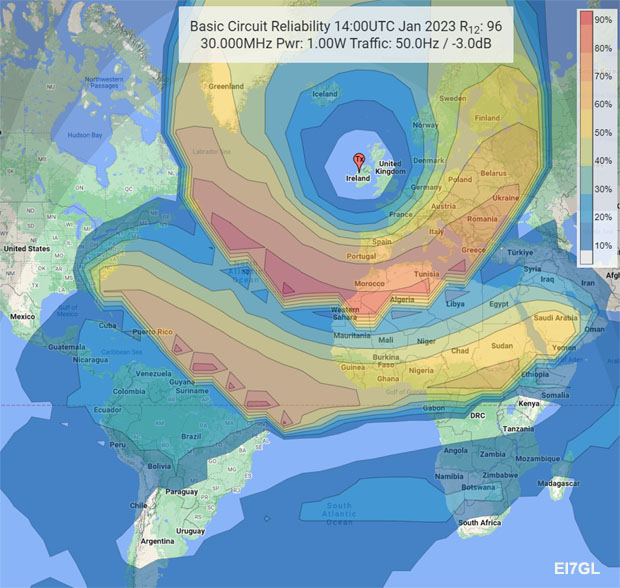Phil, EI9KP is located in the north-west of Ireland and he carried out a propagation experiment on 32.013 MHz on Saturday 27th January 2024 from 09:00 to 17:00 UTC. He was running 5-watts into a vertical dipole and used FT8 and CW to ID.
And yes, before anyone asks, that's not a mistake. Radio amateurs in Ireland have permission to use 32 MHz.
Report from Phil, EI9KP... "I had my Low VHF antennas bent and broken in storm 'Isha' and am in the process of rebuilding. A few days ago I resurrected my Low VHF Test Dipole. Since there are now no coupled dipoles the test dipole was resonant on 31.600MHz. I measured an SWR of 1.5 on 32.013MHz, it looked like a good opportunity to reconnect the beacon for a day.
I have received the following reception reports (PSKReporter, email, EI7GL blog):"
Europe... These are the stations in Europe that heard the signal...
Gintas, LY2YR in Lithuania (KO24OS) at 2188kms was probably F2 layer
Ari, OH5FI/OH5KUY in Finland (KP41DB) logged several FT8 signals and gave this report...
Max: 240127_105300 22 -0.5 243 DE EI9KP IO54.
Min: 240127_142815 -14 -0.3 242 DE EI9KP IO54
73 / OH5KUY
At 2316kms, the propagation mode was likely F2 again.
Costas, SV1XV in Athens, Greece (KM18UA) at 3045kms reports the following... "I can also receive EI9KP beacon on 32013.0 kHz CW, RST 559, giving loc IO54MB. Time 15:18 UTC, loc KM18." and " I can receive EI9KP beacon on 32013.2 kHz FT8, peaking at -11 dB. Time 15:10 UTC, loc KM18."
Alex, SV8QG in Greece (KM39GC) at 3133kms logged some FT8 signals from 10:52-11:01 UTC. Alex sent on the following decodes...
QRG 32,O12 USB REC IC-7200 ANT 4L@10m QTH KM39GC
105300 1 -0.5 1200 ~ DE EI9KP IO54
105315 -7 -0.3 1201 ~ DE EI9KP IO54
105400 -1 -0.5 1200 ~ DE EI9KP IO54
105415 -3 -0.4 1200 ~ DE EI9KP IO54
105500 -2 -0.5 1201 ~ DE EI9KP IO54
105515 -7 -0.4 1200 ~ DE EI9KP IO54
105600 -1 -0.5 1200 ~ DE EI9KP IO54
105615 4 -0.4 1201 ~ DE EI9KP IO54
105700 3 -0.5 1200 ~ DE EI9KP IO54
105715 5 -0.4 1200 ~ DE EI9KP IO54
105800 -7 -0.5 1200 ~ DE EI9KP IO54
105815 -8 -0.3 1201 ~ DE EI9KP IO54
105900 -1 -0.5 1200 ~ DE EI9KP IO54
105915 4 -0.4 1200 ~ DE EI9KP IO54
110000 -1 -0.5 1200 ~ DE EI9KP IO54
110015 -9 -0.4 1200 ~ DE EI9KP IO54
110100 -4 -0.5 1200 ~ DE EI9KP IO54
110115 5 -0.4 1200 ~ DE EI9KP IO54
EI9KP writes.. "Many thanks to Hugh for an all day reception report which I have represented in a graph above. Scatter throughout the day with signals -15/-20 dB SNR with a 10 minute peak at around 12:28 UTC."
Andrew, K8EL in Ohio (EN91EB - 5383kms) sends on the following screenshot...
Larry, VO1FOG in Newfoundland, Canada (GN37IN - 3146 kms) reports that the beacon was in from 1230 till switch-off at 1707 UTC.
Larry also took a nice video of the reception...
As heard here in GN37in at circa 0900 local... pic.twitter.com/axxTC2naVI
— VO1FOG (@VO1FOG) January 27, 2024
K8EL in Ohio EN91EB
EI9KP concludes... "It is worth noting that stations VA2CY and K8EL and on the same line viewed from IO54MB. Last reception reports from Europe were at 1520 (Greece) and 1707 (Canada)."
In conclusion... It's nice to see that one experimental transmission on an odd frequency in the low-band VHF region generated so much interest. It's unlikely we'll see any amateur radio activity from other countries at 32 MHz but that doesn't mean people can't experiment and try to listen.
No doubt Phil will be carrying out more experiments on 32 MHz in the future and we'll try and get the word out a few days earlier for the next one.
Link... I have the results of some previous 34 MHz propagation tests up on my 40 MHz page.















































